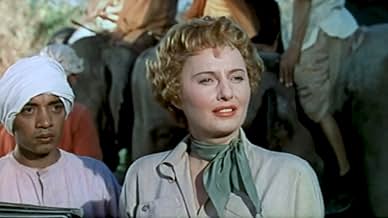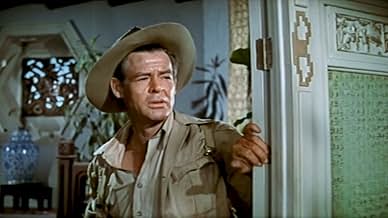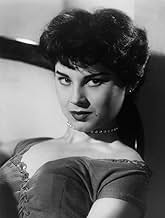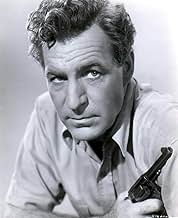IMDb RATING
5.5/10
733
YOUR RATING
A fugitive in British Burma hides on a teak plantation, thanks to a mutual attraction with owner Gwen Moore.A fugitive in British Burma hides on a teak plantation, thanks to a mutual attraction with owner Gwen Moore.A fugitive in British Burma hides on a teak plantation, thanks to a mutual attraction with owner Gwen Moore.
- Director
- Writers
- Stars
Wag Blesing
- Minor Role
- (uncredited)
- Director
- Writers
- All cast & crew
- Production, box office & more at IMDbPro
Featured reviews
it must have been quite impressive for it's time - Color film, old-time film noir star B. Stanwyck and film military hero Robert Ryan were the big attractions in this far-away-location B movie; one of the 2-movie pack in the discount bin from TCM. it DOES have crystal-clear color photography andexcellent sound. Lots of messing about with elephants and tigers, and actors reciting monotone lines; the script needed some more zing or something - not much of a plot in the first half, but it gets better as it goes along. This was made about 10 years before Stanwyck's starring role in "Big Valley". Robert Ryan redeemed himself by doing "Longest Day" and "Battle of the Bulge" after this. Directed by Allan Dwan, who had started in 1911 in silents, and had worked his way up in every occupation in the film industry.
"Escape to Burma" stars Barbara Stanwyck and Robert Ryan...but exceptional actors. Sadly, however, the material is just okay...and the setting really didn't work.
The story is, naturally, set in Burma (nowadays, called Myanmar). The prince has died and his father is livid and swears to kill the person responsible. Soon after this, Jim (Ryan) arrives at a plantation owned by Gwen (Stanwyck) and she almost immediately seems smitten by him. He's also very helpful and she soon makes him her new foreman. However, soon a government official shows up...announcing that Jim is wanted for the Prince's murder. Jim, of course, insists he didn't do it and Gwen helps him escape. What's next? See the film.
The story is okay. But the big reason I wasn't thrilled with the movie is that all the 'Burmese' people look about as Burmese as Keye Luke or Mantan Moreland! Most of them were just extras with body paint to make them look 'exotic'! Additionally, little detail was given to the little things...such as a chimp (an African animal) and other non-Asian animals. Overall, a film that seems to have a very naive view of Burma, an okay script and very good acting.
The story is, naturally, set in Burma (nowadays, called Myanmar). The prince has died and his father is livid and swears to kill the person responsible. Soon after this, Jim (Ryan) arrives at a plantation owned by Gwen (Stanwyck) and she almost immediately seems smitten by him. He's also very helpful and she soon makes him her new foreman. However, soon a government official shows up...announcing that Jim is wanted for the Prince's murder. Jim, of course, insists he didn't do it and Gwen helps him escape. What's next? See the film.
The story is okay. But the big reason I wasn't thrilled with the movie is that all the 'Burmese' people look about as Burmese as Keye Luke or Mantan Moreland! Most of them were just extras with body paint to make them look 'exotic'! Additionally, little detail was given to the little things...such as a chimp (an African animal) and other non-Asian animals. Overall, a film that seems to have a very naive view of Burma, an okay script and very good acting.
It is one of the cliches of mainstream Hollywood cinema that the desire of the hero is limited to two options - a good girl (marriage, security, family, society), and a bad girl (lust, transgression). In this scenario, women are barely people at all, more embodiments of Law and Desire, the socially acceptable and unacceptable.
Not the least of this brilliant film's achievements is the way it transfers this cliche to the heroine, making it new and strange. It is the two male characters who represent the two options open to the woman - Robert Ryan is the outlaw, suspected murderer and jewel thief, sexually direct; David Farrer is the policeman, punctiliously obeisant to the law, sexually repressed.
Ryan hasn't stepped foot in Barbara Stanwyk's elephant ranch before he's made himself at home, made her frankly voracious and got her talking about 'marriage', which we suspect has little to do with religious ceremonies. Farrer no sooner arrives then he wants to take a man home with him. The film's most striking scene occurs near the climax, in the symbolic space of an abandoned, monkey infested Buddhist temple, the two men grappling like Lawrentian blood brothers, and Stanwyk gaping hungrily on, absolutely thrilled.
This central twist is part of the film's wider iconoclasm. Like more renowned peers (Minnelli, Sirk etc.), Dwan takes reactionary material and dismantles it. Firstly, the film offers an odd mish-mash of genres. The film is supposedly set in Burma and its environs, but this is an Orient in the tradition of Powell and Pressburger, the hero of whose 'Black Narcissus' stars here (Farrer).
Whereas 'Narcissus' was a work of complete, defiant artifice, 'Escape' offers a disturbing clash between real location footage and cramped studio sets, often within the one scene which, especially in action sequences, has a jarring, alienating effect. The most notable example occurs early on, when Ryan and Stanwyk hunt a marauding tiger - the effect takes us out of the 'realistic' adventure and alerts us to a more symbolic plane.
Although the film is set in the east, the three genres it evokes originate much further away. Even though the film is an action adventure - and a very exciting one, full of chases, gun-fights and dangerous animals - it is also a melodrama, about a lonely woman stranded in the middle of nowhere, powerful but so starved of 'companionship' she'll attach herself to the first man who comes along. Some of the lighting effects and careful compositions recall the contemporary melodramas of Sirk. The film also belongs to the jungle sub-genre, full of thick forests and animals being cute.
Most important, however, the film is a transposed Western, with Ryan as the outlaw hiding out in Stanwyk's ranch, and Farrer the sherriff sent to being him back. Except, like Ray's 'Johnny Guitar', the colour, the mise-en-scene, the extravagant sexual rituals tend to undermine macho Western self-importance; a female 'Eastern' reflecting back the male Western.
As the scene I mentioned earlier suggests - the brawl in the temple - the idea of play figures throughout, with narrative action turned into ritual or theatre, with extras, ceremonial gestures, and, most importantly, an audience. The most alarming of these is Ryan's torture, but throughout there is an emphasis on people watching, usually obscurely, through gaps and grills, or being framed in proscenium arches within the narrative frame.
Another motif alerting us to mistrust appearances is the mirror- so often a symbol of metamorphosis or revelation; actual mirrors co-exist with mirroring scenes, for example the symmetrical skulking of Stanwyk and the tiger watched by Ryan (doubly mirrored and reversed in the temple scene)
Not the least of this brilliant film's achievements is the way it transfers this cliche to the heroine, making it new and strange. It is the two male characters who represent the two options open to the woman - Robert Ryan is the outlaw, suspected murderer and jewel thief, sexually direct; David Farrer is the policeman, punctiliously obeisant to the law, sexually repressed.
Ryan hasn't stepped foot in Barbara Stanwyk's elephant ranch before he's made himself at home, made her frankly voracious and got her talking about 'marriage', which we suspect has little to do with religious ceremonies. Farrer no sooner arrives then he wants to take a man home with him. The film's most striking scene occurs near the climax, in the symbolic space of an abandoned, monkey infested Buddhist temple, the two men grappling like Lawrentian blood brothers, and Stanwyk gaping hungrily on, absolutely thrilled.
This central twist is part of the film's wider iconoclasm. Like more renowned peers (Minnelli, Sirk etc.), Dwan takes reactionary material and dismantles it. Firstly, the film offers an odd mish-mash of genres. The film is supposedly set in Burma and its environs, but this is an Orient in the tradition of Powell and Pressburger, the hero of whose 'Black Narcissus' stars here (Farrer).
Whereas 'Narcissus' was a work of complete, defiant artifice, 'Escape' offers a disturbing clash between real location footage and cramped studio sets, often within the one scene which, especially in action sequences, has a jarring, alienating effect. The most notable example occurs early on, when Ryan and Stanwyk hunt a marauding tiger - the effect takes us out of the 'realistic' adventure and alerts us to a more symbolic plane.
Although the film is set in the east, the three genres it evokes originate much further away. Even though the film is an action adventure - and a very exciting one, full of chases, gun-fights and dangerous animals - it is also a melodrama, about a lonely woman stranded in the middle of nowhere, powerful but so starved of 'companionship' she'll attach herself to the first man who comes along. Some of the lighting effects and careful compositions recall the contemporary melodramas of Sirk. The film also belongs to the jungle sub-genre, full of thick forests and animals being cute.
Most important, however, the film is a transposed Western, with Ryan as the outlaw hiding out in Stanwyk's ranch, and Farrer the sherriff sent to being him back. Except, like Ray's 'Johnny Guitar', the colour, the mise-en-scene, the extravagant sexual rituals tend to undermine macho Western self-importance; a female 'Eastern' reflecting back the male Western.
As the scene I mentioned earlier suggests - the brawl in the temple - the idea of play figures throughout, with narrative action turned into ritual or theatre, with extras, ceremonial gestures, and, most importantly, an audience. The most alarming of these is Ryan's torture, but throughout there is an emphasis on people watching, usually obscurely, through gaps and grills, or being framed in proscenium arches within the narrative frame.
Another motif alerting us to mistrust appearances is the mirror- so often a symbol of metamorphosis or revelation; actual mirrors co-exist with mirroring scenes, for example the symmetrical skulking of Stanwyk and the tiger watched by Ryan (doubly mirrored and reversed in the temple scene)
Robert Warwick is an independent Burmese price, and his son has been murdered, shot dead. All the evidence points to Robert Ryan. Local British commissioner Reginald Denny says that Ryan must be brought to Rangoon and tried, and orders the most able police officer available to him, David Farrar, to do so. But Ryan makes his way through the jungle to the teak plantation run by Barbara Stanwyck, and gains her trust and love. When Farrar shows up, she helps Ryan escape. Farar pursues him.
Director Allan Dwan's 399th movie is beautifully photographed by John Alton, and with Ryan and Stanwyck, there are some impressive pyrotechnics in the acting. Unfortunately, there's some annoying idiot plotting in the denouement, evidence that would have wrapped the entire story up in less than ten minutes. Of course, then we couldn't have seen Miss Stanwyck lording it over the locals, treating well-behaved elephants kindly, . Neither would we have witnessed a slugfest between Ryan and Farrar, nor a gun battle in which Warwick's troops try to murder the three principals in a savages-invading-the-fort dust-up that was hoary by the time this movie was made. If that's your idea of a good time..
Director Allan Dwan's 399th movie is beautifully photographed by John Alton, and with Ryan and Stanwyck, there are some impressive pyrotechnics in the acting. Unfortunately, there's some annoying idiot plotting in the denouement, evidence that would have wrapped the entire story up in less than ten minutes. Of course, then we couldn't have seen Miss Stanwyck lording it over the locals, treating well-behaved elephants kindly, . Neither would we have witnessed a slugfest between Ryan and Farrar, nor a gun battle in which Warwick's troops try to murder the three principals in a savages-invading-the-fort dust-up that was hoary by the time this movie was made. If that's your idea of a good time..
This is a movie full of charm that I talk about helped by a splendid cast, magical score and atmosphere, despite the studio lot obvious settings. The pure example of what the fifties could bring us in terms of adventure flicks. Benedict Bogeaus provided most of last films from prolific director Allan Dwann. Robert Ryan and Barbara Stanwyck shine at their best here and the animal presence gives a delightful touch to the whole. No matter the intrigue, story, only enjoy the atmosphere. John Alton proves one more time his magical talent as director of photography. This movie is a jewel by itself, and not only those what it is question in the story.
Did you know
- TriviaSharon Lee's debut.
- GoofsIn the Burmese jungle temple, some of the apes are chimpanzees, which only live in Africa.
- Quotes
Gwen Moore: You may mount.
- ConnectionsReferenced in The Exiles (1961)
- How long is Escape to Burma?Powered by Alexa
Details
- Release date
- Country of origin
- Language
- Also known as
- Escape to Burma
- Filming locations
- World Animal Jungle Compound, Thousands Oaks, California, USA(tiger hunt scene)
- Production companies
- See more company credits at IMDbPro
- Runtime1 hour 27 minutes
- Aspect ratio
- 2.00 : 1
Contribute to this page
Suggest an edit or add missing content

Top Gap
By what name was Les rubis du prince birman (1955) officially released in India in English?
Answer































